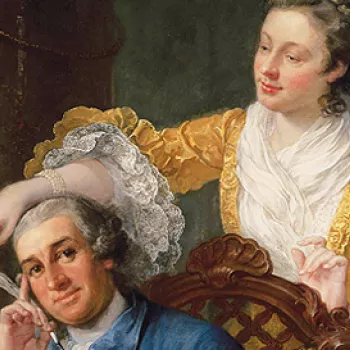Caligula depositing the Ashes of his Mother and Brother in the Tomb of his Ancestors c.1647
Oil on canvas | 161.3 x 122.3 cm (support, canvas/panel/stretcher external) | RCIN 404983
-
Le Sueur was a pupil of Simon Vouet (1590–1649) who was much commended in the literature of the seventeenth century for deserting the style of his teacher in favour of that of Nicolas Poussin and Raphael, though he never made the trip to Italy. Le Sueur’s reputation reached its zenith in the eighteenth century, when he was regarded as the ‘French Raphael’.
This work was painted in 1647 for Claude de Guénégaud for his Hôtel in the Marais (since destroyed) as one of a pair, though the other painting is now known only from preparatory drawings. The story this painting comes from Suetonius’ Life of Caligula, who began his reign on a wave of popularity and relief at the death of his predecessor, Tiberius. Caligula particularly impressed the Roman people by the piety with which he returned to Rome the ashes of his brothers and mother, exiled and murdered by Tiberius.
This scene is set in a graveyard with, to the right, the Pyramid of Gaius Cestius, a familiar Roman funereal landmark. Caligula is shown seated to the right with a laurel crown and baton of office. He gestures towards an elderly priest, who is in the act of placing one urn into one of the arches in the base of a sarcophagus, revealed by removing the slab of marble at his feet. A second urn rests on a tripod table at which kneels an acolyte. To the right, another priest looks on while, to the left, a group of soldiers strain forward to pay their respects with their standards and lances seen against the sky.
Part of Caligula’s appeal was that he was said to be ‘born in a barracks’. Suetonius relates that as a child he wore the miniature uniform of a private soldier, including the caliga, or half-boot, from which he gained his nick-name ‘Caligula’ (little boot) and which he wears here. All this gave him a special hold on the affections of the common soldier. These subjects must have been chosen by Claude de Guénégaud with good reason; to us they remain puzzling, for Lucius Caligula turned out to be an infamous monster. Perhaps we are to recognise an angry petulance in Caligula’s expression, which allows us to read dramatic irony in what is otherwise a conventional image of piety.Provenance
Acquired by Frederick, Prince of Wales'; recorded in the 2nd Room at Leicester House in 1749
-
Creator(s)
-
Medium and techniques
Oil on canvas
Measurements
161.3 x 122.3 cm (support, canvas/panel/stretcher external)
182.3 x 144.3 x 7.5 cm (frame, external)
Category
Object type(s)
Alternative title(s)
Nero depositing the Ashes of Germanicus
The Funeral of Poppaea









